|
Introduction to New Testament Criticism
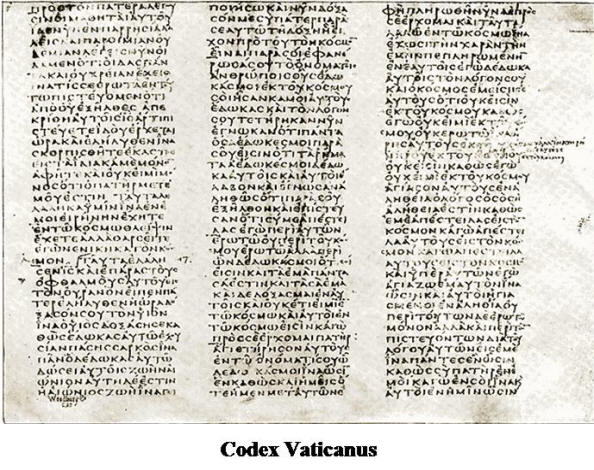 When either the Old or New Testament is read in
English, the reader needs to understand they are reading a
translation. The translation is based on manuscripts, copies of
copies, which were transmitted over time by humanity. Since the
original autograph does not exist, we depend on faithful
transmission of the text. Textual Criticism understands with the
human process of translation, there exists the potential of
transmittal errors. When either the Old or New Testament is read in
English, the reader needs to understand they are reading a
translation. The translation is based on manuscripts, copies of
copies, which were transmitted over time by humanity. Since the
original autograph does not exist, we depend on faithful
transmission of the text. Textual Criticism understands with the
human process of translation, there exists the potential of
transmittal errors.
The purpose of textual criticism is to restore as near as
possible the words of the autograph. This is done by examining
the evidence, the manuscripts, comparing the manuscript to
manuscript.
The New Testament manuscripts contrasted to the Old
Testament manuscripts has a greater quantity, closer to the date
of authorship but lower in quality. There are about 5400 Greek
New Testament manuscripts, which allows us to verify the
transmission of the Greek manuscripts.
The dynamic links between manuscripts, manuscript
transmission and textual criticism can clearly be illustrated in
the commonly known, Textus Receptus,
which is the Greek text used in the translation of the King
James bible of 1611.
Textual Criticism of the New Testament
In textual criticism of the New Testament, we need
to understand the role Greek New Testament manuscripts play.
Since the New Testament was written in Greek, the Greek
manuscripts are the closest point to the original autographs.
During the transmission process, variations occur, because
manuscripts are copied by hand, these copyist variations, then
copies of the manuscript over time. These variations allow us
to trace families of manuscripts because of similarities
contained with the documents.
Variations
Just what is a variation? The vast majority of variations have
very little impact on the meaning of the manuscript. A
variation is just what means, if one manuscript spells the word
different there is a variation. If one manuscript has different
punctuation, that is a variation.
To put these variations between manuscripts in
context, Paul Wagner writes,
“The verbal agreement between various New Testament manuscripts
is closer than between many English translations of the New
Testament and that the actual number of variants in the New
Testament is small (approximately 10 percent), none o which call
into question any major doctrine.
The greatest number of
variants are differences or errors in spelling. For example,
the author of Codex Vaticanus spells “John” with only one n
instead of the common spelling with two. This type of variant
makes no difference in the meaning of the text.
The second largest group
arises because of omissions of small Greek words or variations
in word order. For example, in Greek a person a person’s name
may or may not be preceded by an article (“the”). And the phrase
the good man could also be written in Greek as “the man, the
good one” although in English both phrases are translated “the
good man.” These types of variants also make no difference to
the meaning of the text.
Textual criticism’s goal is to reach back to the autograph,
examining the variations to determine, what exact words would
have been in the autograph.
Procedure for New Testament Textual
Criticism
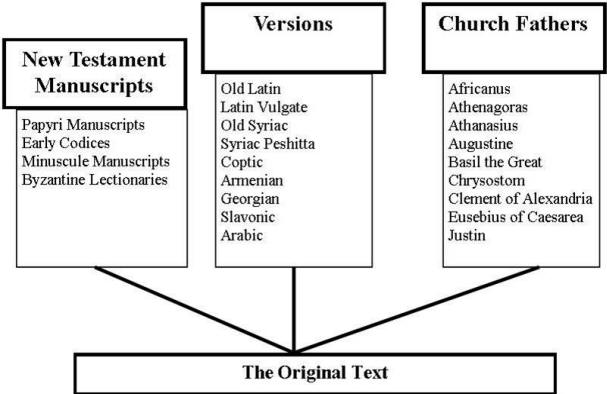
1. Collecting the evidence
Like the Old Testament, the purpose of Textual Criticism is to
try to restore as near as possible the original autograph, by
examining the manuscript evidence. So the procedure would be to
first to collect the available evidence. The three primary
sources of this evidence are:
1. New Testament Manuscripts
2. The writings of the Church Fathers
3. Early translation versions
2. Evidence evaluation
Human beings copied the Old Testament, and they also copied the
New Testament, the errors of Old Testament copyist are the same
as those in the New Testament.
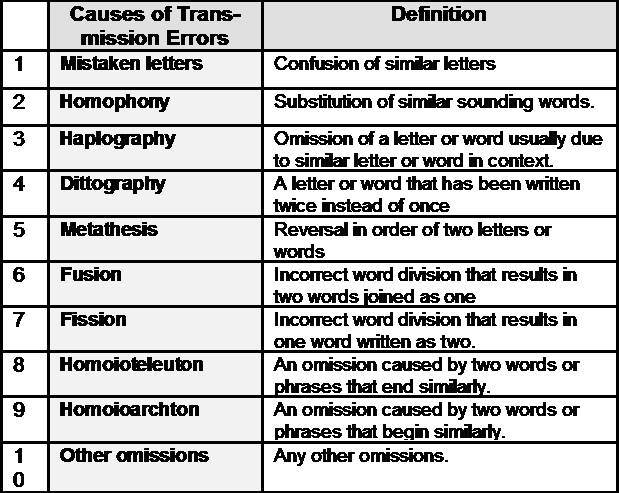
3. Determine the most plausible
reading
There are six principles used to determine the most plausible
reading, when comparing the evidence of a verse.
1. Manuscripts must be weighed, not counted
2. Determine the reading that would most likely give rise to the
others.
3. The more distinctive reading is usually preferable.
4. The shorter reading is generally favored.
5. Determine which reading is more appropriate in its context
(examine literary contexts, grammatical or spelling errors,
historical context).
6. Examine parallel passages for any differences and determine
why they may appear.
History of New Testament Textual
Criticism
From the autographs, the New Testament spread
throughout the Greek speaking world, as manuscript copies were
made by the various growing Christian communities. As
Christianity became more established, copies of manuscripts
continued to be made, some more careful then others. As the
Christian faith reached the non-Greek speaking world,
translations of the New Testament scriptures also came into
existence.
The Latin Vulgate
One of the first languages, which the New and Old
Testaments were translated into was Latin, specifically Old
Latin, the official language of the Roman Empire. When
Constantine, the Roman Emperor became Christian (A.D. 312),
Christianity became the religion of the Roman Empire.
Accordingly, the Greek scriptures were translated into Old
Latin, since Latin was the official language of Rome. By A.D.
382, the variations of in the Old Latin translations reached an
unacceptable point.
In 382, Pope Damascus appointed Eusebius
Hieronymus, known as St. Jerome, the Biblical scholar of his
day to conform the Latin text with the Greek text. Jerome used
textual criticism, by comparing the Latin manuscripts to the
Greek manuscripts, making sure the Latin translation was in line
with the Greek, this process took 2-years (382-390). Bruce
Metzger, refers to the process of Jerome translation, which
later became known as the Vulgate (“common”).
“He used a relatively good Latin text as the basis for his
revision, and compared it with some old Greek manuscripts. He
emphasizes that he treated he current Latin text as
conservatively as possible, and changed it only where the
meaning was distorted.”
Jerome’s Vulgate NT
translation became the standard Bible for the Roman Empire for
the next 1000-years, despite the fact copyist were included in
the transmission of the Vulgate.
The Latin Bible was well
established in Europe as the official Bible, however the only
ones who could read and understand its message, were clergy and
those fluent in the ancient languages. Several events would
occur in the 15th century, which would change the
status quo of the Latin translation.
The Greek Text Revisited
The excessive
ecclesiastical control over catholic nations and abusive clergy
brought about a reformation movement, which was fueled by the
printing press developed by Johann Gutenberg (1398-1468), in
1466. Gutenberg printed the Latin Vulgate, but for the first
time the possibility of less expensive books (manuscripts)
became a reality.
On May 29th,
1453 Constantinople fell to the Turkish armies, this caused many
of the Greeks, who were part of the eastern church to flee to
the west with their Greek manuscripts. Until this time the
Latin Vulgate translations stood unchallenged as authority of
scripture for both the Catholic church and clergy. In Germany,
England and other European countries, movements to translate
scripture into vernacular languages began to take hold. Advances
in printing made Bibles more accessible available for the common
man. The rebirth of the scripture caused a need for a Greek
text of scripture. What
Erasmus’s Greek New Testament
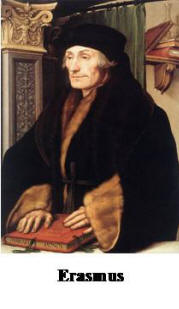 Like Jerome a thousand
years earlier, translators could use the Vulgate, or they could
look at the available Greek manuscripts as the source of their
translation work. In Italy by 1471, there were two versions of
an Italian Bible, in Spain the Bible was translated in 1478, in
France 1487 and a Dutch version in 1477. A revival of scripture
had taken hold in Europe pitting many of its leaders against the
established Catholic Church. The Greek text of scripture had
yet to be published yet, this was about to change with
Desiderius Erasmus of Rotterdam ( 1466-1536), who is credited
preparing the first Greek text in 1516. Like Jerome a thousand
years earlier, translators could use the Vulgate, or they could
look at the available Greek manuscripts as the source of their
translation work. In Italy by 1471, there were two versions of
an Italian Bible, in Spain the Bible was translated in 1478, in
France 1487 and a Dutch version in 1477. A revival of scripture
had taken hold in Europe pitting many of its leaders against the
established Catholic Church. The Greek text of scripture had
yet to be published yet, this was about to change with
Desiderius Erasmus of Rotterdam ( 1466-1536), who is credited
preparing the first Greek text in 1516.
Erasmus was born the illegitimate son of a Dutch priest
and a physicians daughter. Both parents died at an early age,
his guardians sent him to a school in Hertogenbosch conducted by
the Brethren of the Common Life, a religious group which taught
the virtue of monastic life. Erasmus became a monk in the
Augustine order (1485-92).
Erasmus became known for his scholarship in Latin
and his disdain for corruption of the church. He was released
from his vows and went on to teach at Cambridge, where he saw he
need to learn Greek.
The Swiss printer Froben asked Erasmus to prepare a
copy of the Greek New Testament, which he agreed. Erasmus left
for Basel Switzerland in July 1515, to begin this work. The
publisher was in a rush to finish the project, knowing Cardinal
Ximenes was also preparing a Greek text for publication, later
known as the Complutum Polygot.
Erasmus had hoped to just find one Greek manuscript for
the whole volume and publish it along side his new Latin
translation this was not the case. He was saw the manuscripts
needed correction, he ended up using a half dozen Greek
Minuscule including Codex 1, a tenth century, which often agrees
with the earlier uncial texts, this he used least. The work was
completed in ten months and had hundreds of typographical
errors. These errors were corrected in later editions.
One of the early disputes about the work of Erasmus
was the verse I John 5:7-8, Erasmus did not include the words
“the Father, the Word and the Holy Ghost: and these three are
one. And there are three that bear witness in earth”. Erasmus
was accused of removing God’s word, Bruce Metzger records his
reply:
Erasmus replied that he had not found any Greek manuscripts
containing these words, though he had in the meanwhile examined
several others besides those on which he relied when first
preparing his text. In an unguarded moment Erasmus promised that
he would insert the Comma Johanneum, as it is called, in
further editions if a single Greek manuscript could be found
that contained the passage. At length such a copy was found
[now designated Greg. 61]—or was made to order! As it now
appears the Greek manuscript had probably been written in Oxford
about 1520 by a Franciscan friar named Froy (or Roy), who took
the disputed words from the Latin Vulgate. Erasmus stood by his
promise and inserted the passage in his third edition (1522),
but he indicated in a lengthy footnote his suspicions that the
manuscript had been prepared expressly in order to confute him.
Erasmus Greek Text had
five editions, Luther used the second edition in his translation
of the German Bible in 1522 and William Tyndale used the third
edition for his English translation. The fourth edition was the
superior work, the text had three parallel columns, the Greek
Text, the Latin Vulgate, and Erasmus’s own Latin translation.
Erasmus incorporated some of Cardinal Ximenes translation work
in his fourth edition seeing the advantages the Complutum
Polygot, Ximenes Greek translation. He used it to modify his
translation. His text became the standard text for about four
hundred years, though there were better.
Robert Estienne (1503-1559) (Stephanus)
Estienne is
also known as Stephanus in Latin, this Paris publisher published
four editions of the Greek New Testament (1546, 1549, 1550,
1551). The first three were prepared for the French government
in Paris, the fourth edition was after Robert Estienne made a
confession of his conversion to the Protestant faith.
In the first
and second editions, Robert Estienne used Erasmus’s work and
Cardinal Ximenes’s Complutum Polygot and combined their
readings. The third edition, included a apparatus with various
readings from 14 Greek manuscripts in the margins. The fourth
edition was of Estienne Greek text was flanked on both sides by
the Latin Vulgate and Erasmus’s Latin translation, this edition
is also the first to appear with modern verse divisions.
Theodore de Beza (1519-1605)
Theodore de Beza succeeded
Calvin in Geneva as the leader of the Reformed Protestant
movement. Early in his life, his family wanted him to be a
priest, he however choose to be married, and secretly married
Claudine Desnoz in 1548. At twenty-nine he renounced the
Catholic faith and went to Geneva where he publicly married
Claudine Desnoz. He published nine editions of the Greek New
Testament during his life. Beza text was very similar to
Stephanus fourth edition (1551).
The work of
Erasmus, Estienne and Beza would be the underlying Greek which
would be used in the King James bible and every English Bible
until 1881.
|
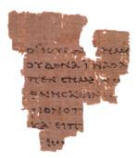 |
The John Rylands Fragment John 18:31-33 (117-138 AD)
The earliest known copy of any portion of the New
Testament is from a papyrus codex (2.5 by 3.5 inches).
It dates from the first half of the second century A.D.
117-138. (P.52)The papyrus is written on both
sides and contains portions of five verses from the
gospel of John (18:31-33,37-38). Because this fragment
was found in Egypt a distance from the place of
composition (Asia Minor) it demonstrates the chain of
transmission. The fragment belongs to the John Rylands
Library at Manchester, England
|
|
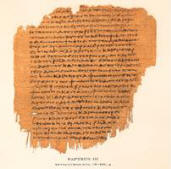 |
Chester Beatty Papyri (250 AD)
This important papyri consists of three codices and
contains most of the New Testament. (P.45, P.46, P.47).
The first codex(P.45) has 30 leaves (pages) of
papyrus codex. Two from Matthew, two from John, six from
Mark, seven from Luke and thirteen from Acts, originally
there were 220 pages measuring 8x10 inches each. (P.46)The
second codex has 86 leaves 11x6.5 inches from an
original, which contained 104 pages of Paul’s epistles.
P.47 is made of 10 leaves from Revelation
measuring 9.5 by 5.5 inches, there were 32 leaves in
originally, chapters 9:10-17:2 remain. P.47 generally
agrees with the Alexandrian text of Codex Sinaiticus (a)))). |
|
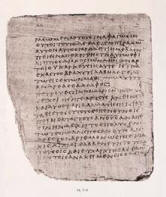 |
Bodmer Papyri (200 AD)
Dating from 200 A.D. or earlier the Bodmer Papyri
Collection (P.66,P.72,P.75) P.66
104-leaves containing the Gospel of John 1:1-6:11,
6:35-14:26, 14-21. The text is a combination of Western
and Alexandrian Text types, twenty alterations belong to
the Western family text type. This papyri was prepared
by four scribes and was part of a private collection, it
measured 6 x 5 ¾ inches and is affiliated with the
Alexandrian text tradition. P.72 has the earliest
know copy of Jude, I Peter, and 2 Peter also contains
other Canonical and apocryphal books. P.72 measures 6 x
5.75 inches. P.75 is 102 pages measuring 10.25 by
5.33 inches. It contains most of Luke and John dated
between A.D. 175 and 225. P. 75 has the earliest known
copy of Luke, the text is very similar to the Codex
Vaticanus. (B)
|
|
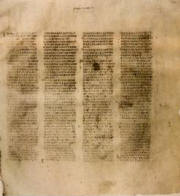 |
CODEX SINATICUS (340 AD) (a)
Unical Text)
Considered by many, to the most important witness to the
Greek text of the New Testament dated in the 4th
century. Sinaiticus is highly valued because of its
age, accuracy and completeness. Found at St. Catherine’s
monastery at Mt. Sinai by Von Tischendorf (1815-1874),
it was acquired for the Czar of Russia. Sinaiticus
contains over 1/2 of the Old Testament (LXX) and all of
the new except for Mark 16:9-20 and John 7:53-8:11..
Also contains the Old Testament Apocrypha. Sinaiticus is
written on 364.5 pages measuring 13.5 by 14 inches. The
material is good vellum made from antelope skins.
Sinaticus was purchased by the British government for
$500,000 in 1933. The type text is Alexandrian with
strains of Western.
|
|
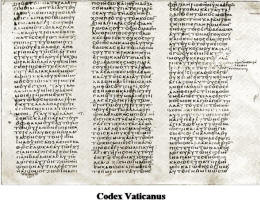 |
Codex Vaticanus (325-350 AD) (B) (Unical Text)
Vaticanus was written in the middle of the 4th century
and was not know to textual scholars until 1475 when it
was catalogued in the Vatican Library. For the next
400-years scholars were prohibited from studying it. It
includes most of the LXX version of the Old Testament
and most of the New. It contains 759 leaves measuring 10
by 10.5 inches. In 1890, a complete photographic
facsimile was made available. Missing from the Codex
Vaticanus is Hebrews 9:14 to the end of the New Testament and
I Timothy through Philemon, some of the OT Apocrypha is
included. Mark 16:9-20 and John
7:53-8:11 were omitted intentionally
from the document. Vaticanus is owned by the Roman
Catholic Church and is housed in the Vatican Library,
Vatican City. Vaticanus is considered an excellent
example of Alexandrian script. |
|





 Like Jerome a thousand
years earlier, translators could use the Vulgate, or they could
look at the available Greek manuscripts as the source of their
translation work. In Italy by 1471, there were two versions of
an Italian Bible, in Spain the Bible was translated in 1478, in
France 1487 and a Dutch version in 1477. A revival of scripture
had taken hold in Europe pitting many of its leaders against the
established Catholic Church. The Greek text of scripture had
yet to be published yet, this was about to change with
Desiderius Erasmus of Rotterdam ( 1466-1536), who is credited
preparing the first Greek text in 1516.
Like Jerome a thousand
years earlier, translators could use the Vulgate, or they could
look at the available Greek manuscripts as the source of their
translation work. In Italy by 1471, there were two versions of
an Italian Bible, in Spain the Bible was translated in 1478, in
France 1487 and a Dutch version in 1477. A revival of scripture
had taken hold in Europe pitting many of its leaders against the
established Catholic Church. The Greek text of scripture had
yet to be published yet, this was about to change with
Desiderius Erasmus of Rotterdam ( 1466-1536), who is credited
preparing the first Greek text in 1516. 



